Little Monsters - Part VI: Dragonfly
Dragonflies are fascinating beasts. One of the largest kinds of flying insect, they are beautiful, fast, voracious predators. They can be seen in the warmer seasons patrolling the skies near lakes, ponds and rivers for many different kinds of insects.
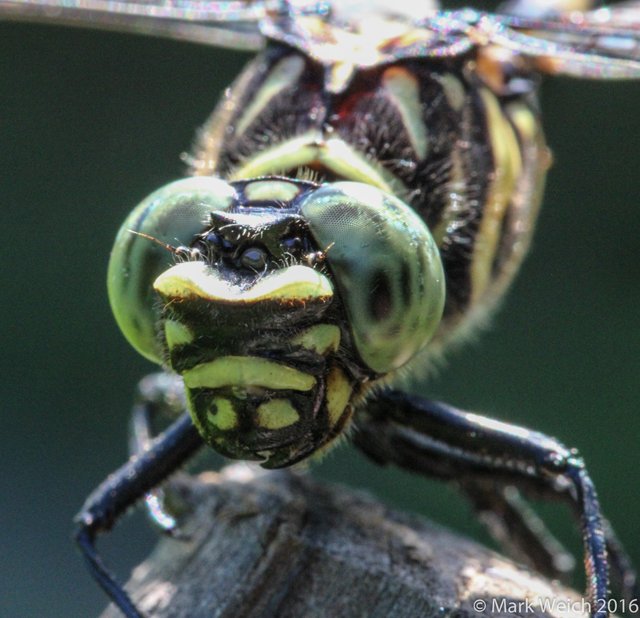
This extreme close-up of a Club Tail Dragonfly give us a good view of why they are such successful hunters. Massive compound eyes provide excellent vision, the primary sense these creatures use to hunt. Two short antennae are also visible as well as the three simple eyes, appearing as black spheres between the two compound eyes, that are common to many kinds of insects. The mandibles are just peeking out from behind a face plate structure at the front of the head. These are used to swiftly dispatch, and butcher it's prey.
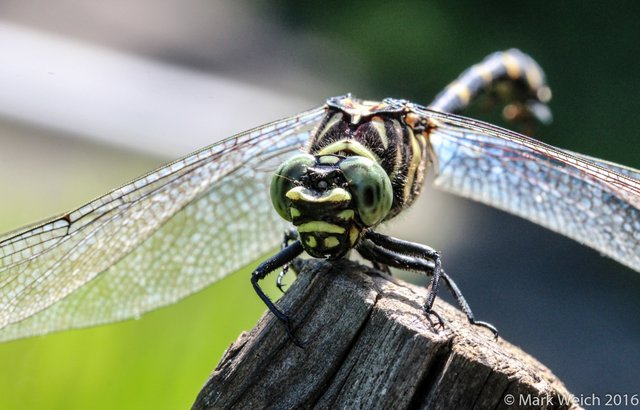
A wider angle allows a better view of the entire dragonfly. It was resting on a fence post, and must have been particularly exhausted as I was able to nudge it's body with my finger. I had though it might have caught its leg in a crack in the wooden post, but no, it was free to move, and merely shifted slightly due to my prodding.
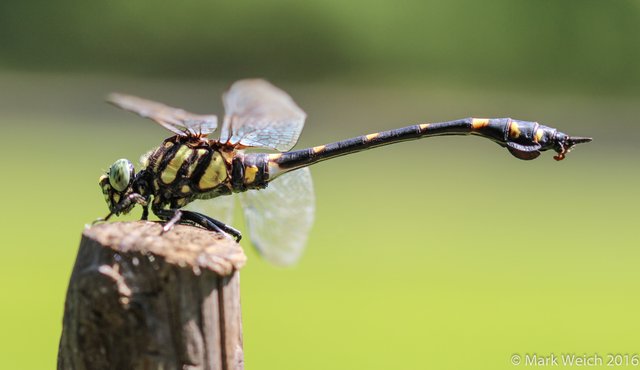
Looking from the side, it is very clear where the name "Club Tail Dragonfly" comes from. The leaf like fins indicate that this particular dragonfly is a male.
There are many species of dragonfly, some even become meals of the other larger ones.
This is a brilliantly blue dragonfly. A bit smaller than the Club Tail above and an unfortunate meal in Part II of this series.
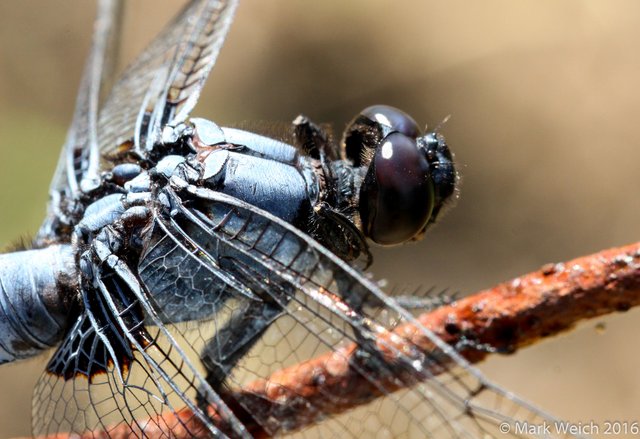
Looking from behind the dragonfly, we can see the head is supported by a very thin neck, giving a wide range of movement. If you observe a resting dragonfly, its head is in constant motion.
One interesting fact about dragonflies is that the wings are "direct action" muscles pull directly on the wing, in contrast to flies, where the wing is hinged and the motion of the thorax being compressed and expanded moves the wings. This direct action allows for very precise control in flight, hovering and even flying backwards!
The wings are like beautiful stained glass windows.
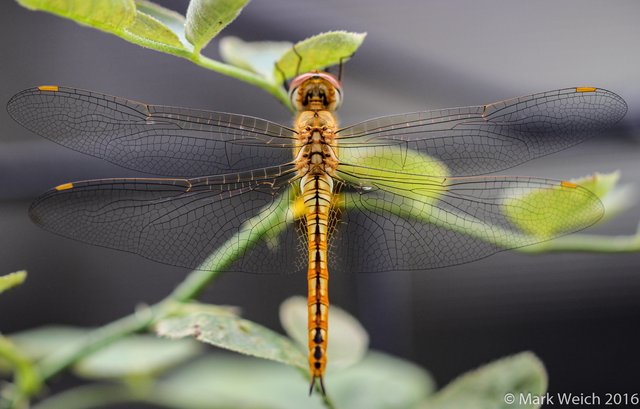
Looking closely, there is a very apparent pattern to the size of each pane in the dragonflies wings. The size and shape of these panes allows for flexion in certain directions and resists it in others. This allows the wing to form the optimal shape when moving through the air for stable and controlled flight.
Most people's image of the dragonfly is the adult stage, flying around skimming over ponds and keeping the mosquito population down. However fearsome they may be in flight. They are truly the stuff of nightmares when they are young.
Depending on the species, some spend 2 to 3 years as aquatic nymphs.
This is the exoskeleton of a larger dragonfly:
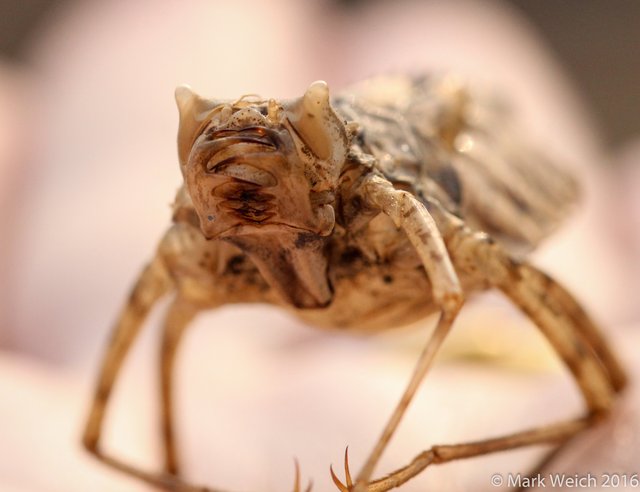
Those clawed hand like structures at the front are the jaws.
The nymph is an ambush predator dining on anything from minnows, tadpoles, and water insects to other dragonfly nymphs.
The side view reveals that those fearsome jaws are mounted on the end of what looks like an arm, folded underneath the head.
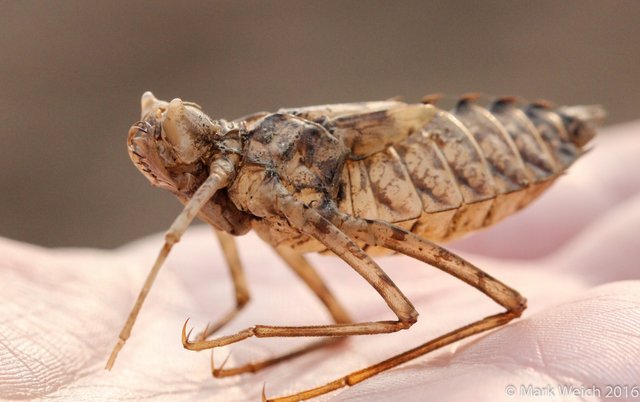
That's exactly what it is.
This is a video of a dragonfly larvae hunting
From nature1upclose 's channel. He's got some really cool stuff.
Please upvote and follow to see the next part of the series in your feed!
Comments, questions and advice are always welcome!
Other parts in this series:
Part V: Black Backed Paper Wasp
Part IV: Decorator Orb Weaver
Part III: Lynx Spiders
Part II: Golden Orb Weaver
Part I: Wolf Spiders
I maintain and reserve copyright on all of my photos.
Wow, from upclose, they look even fascinating. Those wings tho... Awesome...
Indeed, they're quite amazing!
They are like an aliens: scary and interesting, disgusting and amazing :)
Let's just be glad they aren't as big as the were 300 million years ago!
Totally agree! :)
Gorgeous photos, nice work!
Thank you for your support @daveks!
Fascinating shots, you got a new follower :)
Thanks andrew0, I like your work too and have already followed! :)
great great! Wonderful shots! Are you a biologist? why do you know such details?
Amazing! Any particular gear or techniques you use?
For macro, I use a Sigma 105mm Macro lens, patience and practice. Most of the time the lens is at f2.8 but from time to time I stop it down to get more DOF. Recently, I've added an off camera flash though that wasn't used in these pictures. For these spiders I did use it, it was too dark in the house otherwise, and it turned out great! Jumping Spiders
Great! Thanks for the advice. I was thinking about buying a macro lens anyway, so I will look into this one!
Check this. I met the guy on Facebook. He takes these pictures and uses a technique called 'focus stacking' to create these amazing images.
https://steemit.com/photography/@bart2305/what-do-you-think
Haha, I already did check it! Those are some really incredible shots!
I think there was someone that was interviewed, who spends weeks or months with a microscope setup and produces mind blowing huge detailed pictures...Found it!
You must watch it! Levon Bliss Microsculpture
Incredible! Surreal.